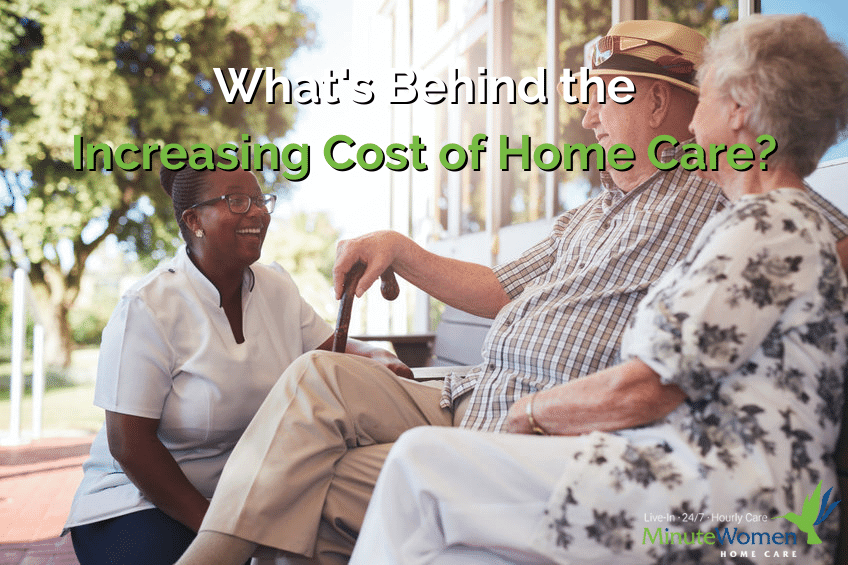What’s Behind the Increasing Cost of Home Care?
Today, we will look at how the increasing cost of home care affects American families. Rising costs widen the gap between who can afford to pay for services and who can not.
It is no secret that the cost of home care is on the rise. However, what may be less known is how this increased cost affects caregivers. This inflation widens the gap between those who can afford to pay for services and those who can not. This article will examine this problem and discuss some possible solutions.
Home care costs affect people in Massachusetts and across the United States. The cost of home care has been rising for many years. Unfortunately, it is now becoming difficult for people to pay for home care services.
This issue is widening the gap between who can afford to pay for services and who can not. It is causing adult children to wipe out their savings to pay for services. In some cases, these families go into deep debt.
Keep reading to learn the causes behind the increasing cost of home care and what you can do to avoid them.
What’s Behind the Increasing Cost of Home Care?
The cost of home care is on the rise, affecting people in several ways.
Baby Boomers and Age in Place
Every day, nearly 10,000 baby boomers turn 65 years old. This trend will continue until 2030, when all baby boomers will be 65+.
The increase in the need for home care services has put pressure on the supply. The baby boomer population is aging. More chronic conditions can receive medical treatments at home with assistance from home care.
Home care services are typically needed once someone is in their 70s. There will be an overwhelming number of boomers who will insist on staying at home.
Demand is still extremely high. The increasing cost of home care will only accelerate over the next decade.
COVID-19
Increasing Demand for Private Home Care
As the COVID pandemic has spread, so has the demand for home care services. This demand is partly because many people are now choosing to stay home rather than risk exposure in public places.
Adding to this, many families experienced difficulties having parents in skilled nursing facilities or assisted living facilities. In 2020, when COVID was spreading like wildfire, there were no vaccines. This trauma left many shaken by sending their parents away.
Families were unable to visit or see their loved ones unless they were dying. This prolonged isolation caused seniors to physically and mentally decline. It was a “damned if you do, damned if you don’t” type of situation that left many families were upset.
Nursing Homes and Assisted Living Facilities
These horrible experiences were terrible P.R. for the communities and facilities and further increased demand for home care services. Families felt that they could see their parents with the home care they needed, even if it increased the risk of infection.
COVID has left nursing homes financially decimated. You should expect many closures, especially in more rural areas. Assisted living communities are staying afloat because of their memory care units. Over time, their traditional side will bounce back (assuming no new variants arise).
All of these have reinforced the position of most seniors and their families. Seniors want to age at home for as long as possible. As a result, the demand for caregivers and home care services will increase. The increasing cost of home care has just started.
Do you need a caregiver to help an elderly family member in your life?
Wage Increases
It is not surprising to hear about wage increases behind the increasing cost of home care. Many states (including Massachusetts) have raised their minimum wages to $15 per hour. With COVID, most employers paying below $15/hr blew past that figure quickly.
Agencies are finding that they are paying substantially more than $15 per hour as COVID dragged on. The lack of caregivers to accommodate these needs increased wages simple supply-and-demand economics.
Families in Massachusetts should expect rates to increase over the next few years. Our prediction is that home care rates will end up in the $39-$42 per hour range. Minimum wage increases and inflation are two primary factors.
The recent events in Ukraine and Russia will also continue to increase inflation. The rising cost of gas will further increase caregiver wages, which agencies will eventually pass to clients.
Less Immigration to the U.S.
Since 2016 visa immigration into the United States has dropped dramatically. At the high of 1,000,000 people in 2016 to just 250,000 visas in 2021.
Foreign-born workers occupy jobs in the services and construction industries at higher numbers. Less immigration into the U.S. has driven up the need to entice these workers to stay in their industry. Otherwise, they often would rather than leave to greener pastures.
This trend is leaving families between a rock and a hard place. As caregivers know, they are in demand and are only willing to accept long-hour, higher-paying shifts.
A family who needs only a few hours of help will have difficulty finding a consistent caregiver. That shift is just the way the home care industry works.
To no fault of their own, caregivers will wait for the most lucrative cases. They will only take a day or less to find more lucrative care from a competing live-in care agency.
Key Takeaways
It is unlikely that inflation increases will reverse. Once wages go up, they stay there.
Because of this, more families will find themselves shocked at the hourly cost and the high minimum number of hours.
The increasing cost of home care will fluctuate from agency to agency. What won’t change is the inconsistency of the caregivers for low-hour cases. This inconsistency leads to agencies declining the case until the family finds one willing to take shorter hours. In these cases, a new caregiver often shows up on each shift. In this situation, everyone is disappointed and frustrated.
Even if a massive crash were to occur in the housing sector, home health care is very insulated. This balance is because seniors pay for savings services. The demand to stay at home and avoid moving into a nursing home will persist. This desire means there will be inflation in the home care industry for the foreseeable future.
If you have questions about taking care of a senior in your life, get in touch with us today!


